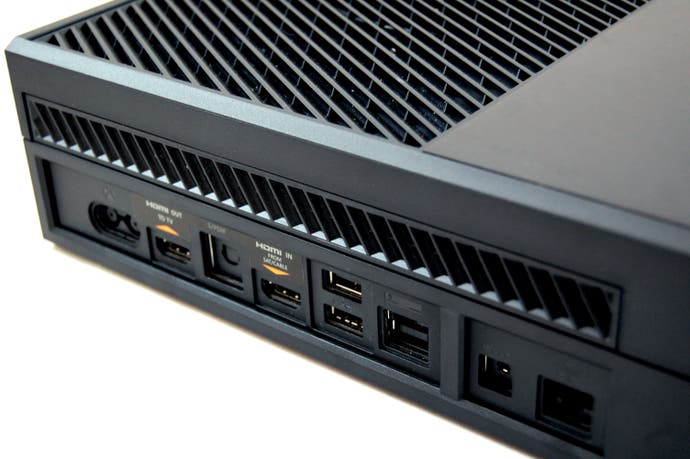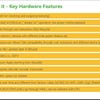Why Xbox One's ambitious media strategy failed
And how its legacy may impact Microsoft's chances of catching PS4.
The pack-in Kinect is no more, and while Microsoft remains bullish on the camera's place at the heart of "the premium Xbox One experience", the reality is clear: for all the right reasons, Kinect has gone from being an integral component to an optional peripheral.
This solves many problems: the price differential with PlayStation 4 has now been addressed, while internal resources dedicated to Kinect processing can now be returned to game developers. On the flipside, the original vision for Xbox One as a multi-faceted all-in-one entertainment system as well as a games machine now lies in ruins. Kinect was at the heart of everything that made Xbox One different and without it we're left with a machine that offers pretty much the exact same proposition as PS4, but without parity in hardware specifications.
This week's announcements are all about levelling the playing field with Sony. The price is the same, Games with Gold moves closer into alignment with PlayStation Plus, while non-gaming services are also like-for-like thanks to the removal of the almost criminal paywall that saw users paying for the privilege of using Internet Explorer, Skype and even non-Microsoft services like YouTube and Netflix - a state of affairs entirely unique to Xbox in a world where all of those services are free on virtually every other device available. It's the latest in a long line of U-turns, but there's the sense that Microsoft is finally listening.
But of all the repositioning carried out this week, it's the removal of Kinect that feels most important, because it's the end of Microsoft's vision for an all-in-one entertainment system. In hindsight, packing in Kinect and making media integration central to the Xbox One proposition looks like an awful mistake. However, put into context, there were perfectly logical reasons for every single element of its failed strategy. So what were they? And what kind of legacy do they leave now that things have changed so dramatically?
"Of all the repositioning carried out this week, it's the removal of Kinect that feels most important - it's the end of Microsoft's vision for an all-in-one entertainment system."

If we turn the clock back to the time where the key technological decisions were being made - towards the end of 2010 and moving into 2011 - we were looking at a fundamental change in the console audience and how gaming hardware was actually being used. Microsoft looked at the ways that gaming was adapting, attempted to anticipate future trends and produced a hardware concept that ticked all the boxes.
Let's not underestimate the sheer wealth of data Microsoft (and indeed Sony) has on its userbase and how we interact with hardware. Online services allow the platform holders to monitor information how your console is being used, what peripherals are attached, what displays you're using and what games and apps are being loaded. Statistics showed that for many users, the Xbox 360 was being utilised more for media streaming than it was for actual gameplay. Nielsen's 2011 research demonstrated that after watching directly from a computer, games consoles were the next most popular form of media streamer.
Meanwhile, the late 2010 launch of Kinect for Xbox 360 was a staggering success, with a phenomenal eight million units shifted, making it the most successful consumer electronics launch in history - and also, according to sources at Microsoft, making Xbox 360 the first console to sell more in its fifth year on the shelves than it did in its fourth. Each of these factors had a profound impact on Microsoft's thinking behind the next-gen Xbox.
Thanks to the remarkable Xbox 720 vision document leak, we actually have a unique insight into the thought processes that produced the Xbox One. Put together as a discussion document for an internal summit hosted during September 2010, the PowerPoint presentation showed us in extreme detail how Microsoft were approaching the follow-up to Xbox 360. Apple and Google were defined as key competitors as well as Sony and Nintendo, while "next-gen sensors" like Kinect and VR/AR glasses were viewed as key points of differentiation that Microsoft could exploit. The need to "appeal to broad audiences" and "scale the business" to set-top boxes and beyond was identified.
"The leaked 2010 'Xbox 720' document reveals that the pack-in Kinect and the media strategy were in place some time before the core Xbox One design was finalised."

It's an ambitious document in many ways, but it's notable that AAA gaming capabilities were probably the least forward-looking element - a target of a mere 4x to 6x Xbox 360 quality is mentioned more than once (though 8x gets a look-in on one occasion). Instead we see more focus on the intriguing new concept of transmedia gaming, where real-time TV and gaming are combined, again with Kinect as the centrepiece. Why just watch the golf when you can actually take part in the event, with stats and performances inserted into the game as it happened? It never happened of course, but it's indicative of the thought processes of the time. There's a sense that Microsoft felt it owned AAA gaming and wanted to do something more, something different. It wrongfully perceived threats from companies that have still yet to mount any kind of challenge to the traditional home console and considered mobile devices as companion technology, rather than the actual destination for the majority of the more casual gamers it craved.
A lot changed in the final Xbox One design, of course. The fact that Microsoft was still debating whether to use ARM or x86 cores demonstrates that the internal discussion took place some time before the hardware was finalised. Xbox 360 backwards compatibility never happened, a mooted modular design that could have led to an upgradable console was shelved (but patents were applied for), OnLive was never acquired and cloud streaming functionality is unlikely to appear on Xbox One any time soon.
But much of the discussed spec made it to the final product - eight x86 cores, ESRAM, a cool and quiet set-top box design and of course the second-gen Kinect. The $50 budget per unit for the main processor sounds about right and even the 120W power envelope mooted in the leaked document was actualised in the final design. But more important than specifics in hardware detail is the overall vision for what the box should be capable of - gaming had to co-exist with media and apps in order to appeal to the broadest possible audience and Kinect was omnipresent in Microsoft's thinking. We can't help but wonder what Sony's equivalent 2010 document would look like. We suspect it would be nothing like this.
"The notion of a multimedia set-top box dominated Microsoft's thinking, defining the core design of the machine - a legacy that may impact its new role as a more traditional console."
What happened next was a mixture of changing market conditions, a stunning revitalisation in Sony's fortunes and poor decision-making on Microsoft's part. The Xbox 720 document points towards a $299 price point - the sweet spot that had served the PlayStation and its successor so well - but the ambition of Microsoft's design along with the need to break even on hardware brought about a $499/£429 sticker price that killed off any idea of Xbox One going mainstream at launch, especially with Sony coming in much cheaper with PS4. Meanwhile, Kinect for gaming simply ran out of ideas on Xbox 360 - it was a one-year flash in the pan, third parties deserted it and, remarkably, even Microsoft itself failed to back the second-gen Kinect with must-have exclusive games for the Xbox One launch.
By the time the new hardware was revealed, controller-free motion gaming felt more like a punchline than the future, and the notion of a mandatory buy-in cost was clearly a bad idea without the software to support it. There was the sense that Microsoft was not listening to the core gamers that defined the success of the Xbox 360 - Kinect was a negative, not a positive, while the TVTVTVTV media functionality was perceived as a value-added feature - not the core of the device as it was presented at the initial reveal. On top of that, the notion of an always-on Kinect surveying our living rooms didn't sit well with allegations that the US government had extensive access to Microsoft's (and others') internet services. Once a mandatory extension of Xbox One, Microsoft was forced to make Kinect detachable from the console, with further privacy options implemented. The decoupling of the camera from the Xbox One had begun even before launch.
By the time the console reached stores, the media features were looking promising but under-developed where it really mattered. Voice control turned out rather well, the ability to seamlessly switch sources also worked beautifully, and the multiple biometric login feature was extremely cool technology. However, the focus on the bleeding-edge tech was at odds with the lack of basic features: there was no sign of DVR options, no 50Hz support, the Blu-ray app was bugged and local/network file playback was left off the spec sheet. Perhaps worst of all, the showcase OneGuide simply didn't work at all outside of the USA. By extension, Blu-ray aside, Xbox One didn't offer any must-have media services that weren't already available on Xbox 360.
"In pre-production, Microsoft considered ambitious concepts to integrate gaming and live TV in ways that never made their way to the final Xbox One."
In retrospect, Microsoft may be wondering whether it should have dropped Kinect pre-launch, much as Sony had done with the PlayStation Camera. However, to do so would have effectively killed all the non-gaming functions before the console had even hit the shelves, and our understanding is that Microsoft still retained faith in the media strategy even when it became clear that sales were flagging.
Internally, the discussion was framed as being about the first platform holder to reach 100m units, not the first to hit five million. The thinking was that Xbox One and Kinect media functionality would win over the mainstream when the price was right. Unfortunately for Microsoft (and indeed Sony), the conditions that allow for a current-gen console price-cut are highly limited - CPU and RAM costs remain at a premium and won't be falling substantially in the immediate future. In the meantime, enthusiasm for Xbox One was flagging. Titanfall was a system-seller, but sales dropped off again with each passing week and the added momentum was short-lived. Dropping the camera or paying for the price-cut itself were the only options available to Microsoft. With that, Kinect was history.
The decision to drop Kinect clearly has more advantages than disadvantages, but it places Xbox One in a difficult situation. The key media and apps strategy decided upon four years ago had a profound impact on the machine's design. Microsoft wanted a cool and quiet unit that could work as a set-top box - a decision that would have informed GPU and memory choice, key areas where it is outspecced by PS4. But it goes beyond that. The basic aesthetics of the console were defined by the media strategy to the point where Xbox One even looks more like an anonymous, slab-like STB as opposed to a stylish state-of-the-art games console.
From a gaming perspective, Kinect wasn't a well-supported device, so moving away from it feels like the best decision Microsoft could have made, but in many respects Xbox One now comes across as a machine designed around a series of concepts that are no longer relevant, elements of its core identity whittled away piece by piece. Microsoft made the decision to trade raw gaming power for a more rounded entertainment concept, sinking enormous amounts of time, money and effort into technologies that much of the userbase never used and that future buyers are even less likely to experience - and we're not just talking about Kinect.
"Is this the end of Kinect? If Microsoft is still working on its 'Fortaliza' VR/AR concept, the camera will play a key role."
Always online, always connected, designed to be left on for 10 years: this was a significant challenge with much time, effort and engineering sunk into it - now pretty much irrelevant as Xbox One becomes more games console than media centre. The HDMI input and passthrough remains, but doesn't work as well without voice control, while centralised control of your TV and sound system is now gone without Kinect. The innovative multi-OS virtual machine set-up is a breathtaking technological achievement, but always came across as unwieldy in action and now falls by the wayside in general usage now that the voice input has gone. Out of the box, the Kinect-free Xbox One is really no more of a media centre than its predecessor - and we can't help wonder whether all that time, effort and energy would have been better spent making the best games console possible instead.
While there is price parity with PS4, a brutal assessment of Xbox One is that we're still looking at a less capable machine retailing for the same price, with few points of differentiation. Communicating whatever it is that makes Xbox One unique, original and different is the new challenge facing Microsoft. Primarily it will be about exclusive titles and third-party content deals, but it's also about rebuilding a relationship with a core userbase that has lost its close sense of connection to the Xbox brand and has grown distrustful of Microsoft itself.
The good news for Microsoft is that games and content will always trump hardware spec. Yesterday's Halo 5 tease was short on details but at least re-introduced a key title with an immense level of goodwill associated with it, and the E3 line-up should be strong. Beyond that we understand that Microsoft isn't done with the cloud, and that games are being built around Azure that go beyond the utilisations we've seen thus far. Microsoft's third-party publishing team never lifted the foot off the gas in terms of securing exclusives, and doubtless we'll see more of their efforts at next month's press event. We won't see a total reboot of Xbox One, but at the very least the focus will be where it should have been from day one - on the games.








